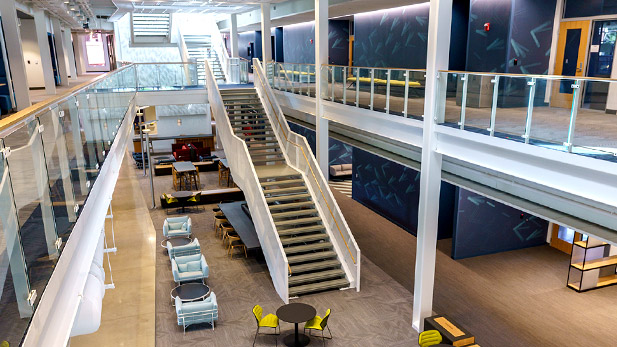New Academic Building Seeking to Be Indiana’s First WELL Certified Structure

The New Academic Building has design and advanced technologies that may earn WELL Certification for enhancing human health and well-being through air, water, nourishment, light, fitness, comfort, and mind features.
Rose-Hulman’s New Academic Building is on track to become Indiana’s first construction project to earn WELL Certification for design and technology that enhances the health, wellness and the human experience for the institute’s students, faculty and staff.
The 70,000-square-foot, $29 million building will open Thursday, August 26, with design, fabrication and rapid prototyping areas, classrooms, state-of-the-art chemistry and biochemistry laboratories, a food science research lab, and student-faculty collaborative workspaces – facilities that will affirm Rose-Hulman’s leadership role in undergraduate science, engineering and mathematics education.
Advanced technologies accentuating these educational areas have been incorporated inside and outside to achieve WELL Certification, a pioneering building program established by the International WELL Building Institute (IWBI). The performance-based system has criteria about a building’s air, water, nourishment, light, fitness, comfort, and mind features that impact human health and well-being.
“Achieving WELL Certification for our New Academic Building will be a significant step forward in our long-standing commitment to incorporate sustainability, health and wellness building standards across our campus,” said Rose-Hulman President Robert A. Coons. “We are committed to supporting healthy living for our students, faculty and staff and elected to pursue WELL Certification in support of that goal. We want our buildings to be functional, economical and beneficial in enhancing all elements of our education mission.”
The building’s designer, Indianapolis-based RATIO Architects, has incorporated WELL features in other projects within Indiana, but Rose-Hulman’s building is the first to be pursuing the official WELL certification, according to Sarah Wood, senior associate and director of sustainability with RATIO Architects.
WELL Certification health and wellness features within the New Academic Building include:
Air: Pollutants and chemicals are being limited through a ventilation system that utilizes fresh outdoor air and filtration/sanitization systems in the air handlers to optimize and achieve indoor air quality.
Water: Occupants will have access to high-quality drinking water, which will be tested and filtered to meet current health standards.
Nourishment: Healthy eating habits are encouraged by providing occupants with healthier food choices and signage to learn about nutrient quality. Tables and chairs allow occupants to sit down, relax and recharge. Rose-Hulman officials also are encouraging better eating habits and food culture throughout campus.
Light: Exterior window performance and shading device design reduce glare while providing views to the outdoors and daylight through every habitable space. Interior light fixtures and controls minimize disruption to the occupant’s circadian rhythm and provide optimal lighting levels, all working to improve occupant energy, mood and productivity.
Fitness: The three-story staircase in the center of the building encourages physical activity and provides the opportunity for chance encounters and interaction. A kinetic art installation titled “Depth of Field” responds to movement and time of day and will attract admiring visitors throughout the campus.
Comfort: Furniture and equipment choices along with temperature controls have addressed ergonomic, visual, acoustic, and thermal comfort, creating an indoor environment that is distraction-free, productive and soothing.
Mind: Classrooms and laboratories surrounding a lobby area on each floor will provide opportunities for personal relaxation and interaction. There also are several meeting rooms for students and teams to collaborate and reflect upon their design projects and other academic activities. Art installations, furniture and material selections, and an outside courtyard all aim to reduce stress while supporting mental and emotional health by incorporating elements of biophilia and nurturing human’s innate connection to nature.
According to the IWBI, WELL Certification concepts are grounded in a body of evidence-based research that explores the connection between buildings, where people spend more than 90% of their time, and the health and well-being impacts of those buildings on occupants.
After its grand opening, the New Academic Building’s operations will complete rigorous testing and a final evaluation by Green Business Certification Inc., a third-party certification body for WELL, to ensure the building meets all of IWBI’s Version 1 WELL Core & Shell Certification performance requirements.
The building’s construction was managed by Garmong Construction Services of Terre Haute. Several subcontractors and local laborers were involved in the project since the summer of 2019.
The project was supported through a $15 million lead gift from an anonymous donor, along with other individual and family donors, as part of the Mission Driven Campaign for Rose-Hulman.